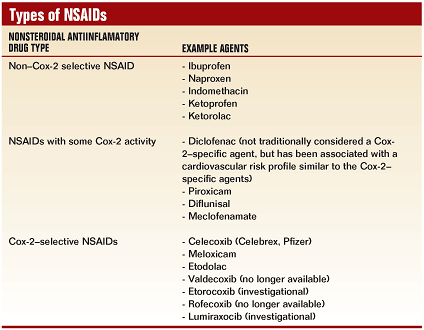Taking steps to reduce NSAID risks
A stepped-care approach is recommended for pharmacologic management after an adequate trial of nonpharmacologic approaches.
A few months ago, the American Heart Association published a scientific statement on the use of nonsteroidal antiinflamatory drugs in people with or at increased risk for heart disease.
The impetus for this report was the lingering concerns related to the association of NSAIDs, particularly Cox-2 inhibitors, and a small but absolute increased risk for cardiovascular events. The authors focused on the broad category of musculoskeletal symptoms, which could include diagnoses ranging from mild tendonitis to something much more severe, such as rheumatoid arthritis.
|
|
To treat musculoskeletal symptoms in those at highest risk for cardiovascular events, a stepped-care approach is suggested for pharmacologic management after an adequate trial of nonpharmacologic approaches, such as application of heat/cold or physical therapy. Although nonpharmacologic approaches may be successful in the milder cases, most, if not all, chronic musculoskeletal disorders will require short-term, intermittent or long-term pharmacologic treatment.
Stepped-care approach
The stepped-care approach to disease management has been a mainstay of hypertension management since 1977, when the first report of the Joint National Committee on Detection, Evaluation, and Treatment of High Blood Pressure (JNC) was published.
Although the number of steps and the drugs of choice at each step have varied throughout the years with subsequent JNC reports, what remains constant is the idea of selecting a drug and dose appropriate for an individual patient, followed by dose titration and/or drug addition as necessary to achieve the goals of therapy (in this case, adequate BP reduction).
Additionally, during the last decade, the stepped-care approach has been incorporated as an important component of the treatment plan for many disorders, including opioid dependency, alcoholism, smoking cessation, mood disorders, obesity, erectile dysfunction, migraine headaches, multiple sclerosis and many others.

The pharmacologic steps recommended in the AHA statement begin with use of agents having the lowest reported risk for cardiovascular events (acetaminophen, aspirin, tramadol and short-term use of narcotics), followed by nonacetylated salicylates, such as Tricosal. Although these agents may have low cardiovascular risk, they are not without other important risks, including gastrointestinal upset and bleeding (all salicylates) and dependency (tramadol and narcotics).
The next steps recommend NSAIDs, beginning with those that have low Cox-2 inhibition activity and then progressing to those that are Cox-2 selective, since those agents with increasing Cox-2 selectivity have been associated with increased cardiovascular risk (see table). At all steps, the lowest dose of an agent should be tried and titrated up in accordance with individual symptom and side effect management.
Importantly, during treatment with NSAIDs, particularly if the agent will be prescribed chronically and/or if a Cox-2 selective is used, modifiable cardiovascular risk factors should be diligently monitored and managed.
NSAID treatment is associated with impaired renal perfusion, sodium retention and increased BP, all of which may contribute to their associated cardiovascular risk. Patients with or at increased risk for CVD should be educated about the importance of dietary sodium restriction and home BP monitoring during therapy with NSAIDs to reduce the potential for adverse cardiovascular outcomes.
In patients requiring aspirin for secondary prevention and chronic NSAID treatment with ibuprofen, the dose of aspirin (administered in an immediate-release formulation) should be taken at least 30 minutes prior to, or eight hours after, ingestion of ibuprofen to minimize ibuprofens’ interference with aspirin’s ability to irreversibly acetylate the platelet Cox-1 enzyme. Additionally, aspirin coadministered with a Cox-2 selective NSAID may reduce the observed GI protective effect associated with selective Cox-2 inhibition.
Upcoming trial
PRECISION (Prospective Randomized Evaluation of Celecoxib Integrated Safety vs. Ibuprofen Or Naproxen, NCT00346216) is a clinical trial currently underway in patients with osteo- or rheumatoid arthritis and a diagnosis of heart disease or identified to be at high risk for CVD.
This trial is a joint effort between the Cleveland Clinic Cardiovascular Coordinating Center and Pfizer and is led by Steven E. Nissen, MD. Researchers plan to enroll 20,000 patients who will be randomly assigned to celecoxib (100 mg to 200 mg twice daily), ibuprofen (600 mg to 800 mg three times daily) or naproxen (375 mg to 500 mg twice daily) and followed for at least 18 months.
The study is designed to assess cardiovascular (primary), gastrointestinal and renal events, as well as symptomatic benefit. Detailed information will be collected for all events, and rigorous adjudication will occur with the hope that the results from PRECISION will allow for a more comprehensive understanding of the risk–benefit profile of these medications in high-risk patients.
Rhonda Cooper-DeHoff, Pharm D, is Assistant Director of Clinical Programs and Research Assistant Professor in the Division of Cardiology at University of Florida College of Medicine, Gainesville. She is a member of the Cardiology Today Editorial Board.
For more information:
- Antman EM, Bennett JS, Daugherty A, et al. Use of nonsteroidal antiinflammatory drugs: An update for clinicians — A scientific statement from the American Heart Association. Circulation. 2007;115:1634-1642.










